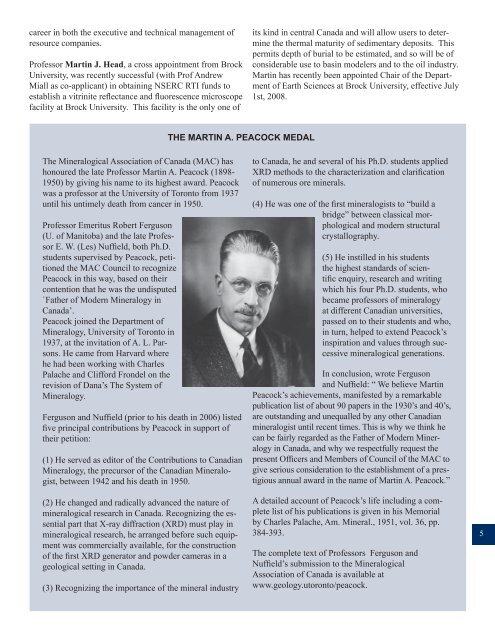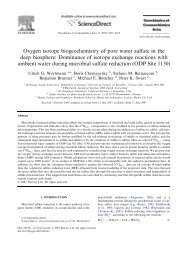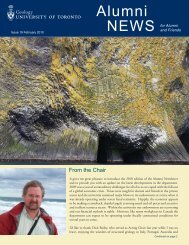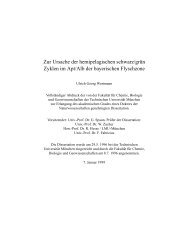13000_final3.ps, page 1-20 @ Normalize ( 13000_final.indd )
13000_final3.ps, page 1-20 @ Normalize ( 13000_final.indd )
13000_final3.ps, page 1-20 @ Normalize ( 13000_final.indd )
Create successful ePaper yourself
Turn your PDF publications into a flip-book with our unique Google optimized e-Paper software.
career in both the executive and technical management ofresource companies.Professor Martin J. Head, a cross appointment from BrockUniversity, was recently successful (with Prof AndrewMiall as co-applicant) in obtaining NSERC RTI funds toestablish a vitrinite reflectance and fluorescence microscopefacility at Brock University. This facility is the only one ofits kind in central Canada and will allow users to determinethe thermal maturity of sedimentary deposits. Thispermits depth of burial to be estimated, and so will be ofconsiderable use to basin modelers and to the oil industry.Martin has recently been appointed Chair of the Departmentof Earth Sciences at Brock University, effective July1st, <strong>20</strong>08.THE MARTIN A. PEACOCK MEDALThe Mineralogical Association of Canada (MAC) hashonoured the late Professor Martin A. Peacock (1898-1950) by giving his name to its highest award. Peacockwas a professor at the University of Toronto from 1937until his untimely death from cancer in 1950.Professor Emeritus Robert Ferguson(U. of Manitoba) and the late ProfessorE. W. (Les) Nuffield, both Ph.D.students supervised by Peacock, petitionedthe MAC Council to recognizePeacock in this way, based on theircontention that he was the undisputed`Father of Modern Mineralogy inCanada’.Peacock joined the Department ofMineralogy, University of Toronto in1937, at the invitation of A. L. Parsons.He came from Harvard wherehe had been working with CharlesPalache and Clifford Frondel on therevision of Dana’s The System ofMineralogy.Ferguson and Nuffield (prior to his death in <strong>20</strong>06) listedfive principal contributions by Peacock in support oftheir petition:(1) He served as editor of the Contributions to CanadianMineralogy, the precursor of the Canadian Mineralogist,between 1942 and his death in 1950.(2) He changed and radically advanced the nature ofmineralogical research in Canada. Recognizing the essentialpart that X-ray diffraction (XRD) must play inmineralogical research, he arranged before such equipmentwas commercially available, for the constructionof the first XRD generator and powder cameras in ageological setting in Canada.(3) Recognizing the importance of the mineral industryto Canada, he and several of his Ph.D. students appliedXRD methods to the characterization and clarificationof numerous ore minerals.(4) He was one of the first mineralogists to “build abridge” between classical morphologicaland modern structuralcrystallography.(5) He instilled in his studentsthe highest standards of scientificenquiry, research and writingwhich his four Ph.D. students, whobecame professors of mineralogyat different Canadian universities,passed on to their students and who,in turn, helped to extend Peacock’sinspiration and values through successivemineralogical generations.In conclusion, wrote Fergusonand Nuffield: “ We believe MartinPeacock’s achievements, manifested by a remarkablepublication list of about 90 papers in the 1930’s and 40’s,are outstanding and unequalled by any other Canadianmineralogist until recent times. This is why we think hecan be fairly regarded as the Father of Modern Mineralogyin Canada, and why we respectfully request thepresent Officers and Members of Council of the MAC togive serious consideration to the establishment of a prestigiousannual award in the name of Martin A. Peacock.”A detailed account of Peacock’s life including a completelist of his publications is given in his Memorialby Charles Palache, Am. Mineral., 1951, vol. 36, pp.384-393.The complete text of Professors Ferguson andNuffield’s submission to the MineralogicalAssociation of Canada is available atwww.geology.utoronto/peacock.5








